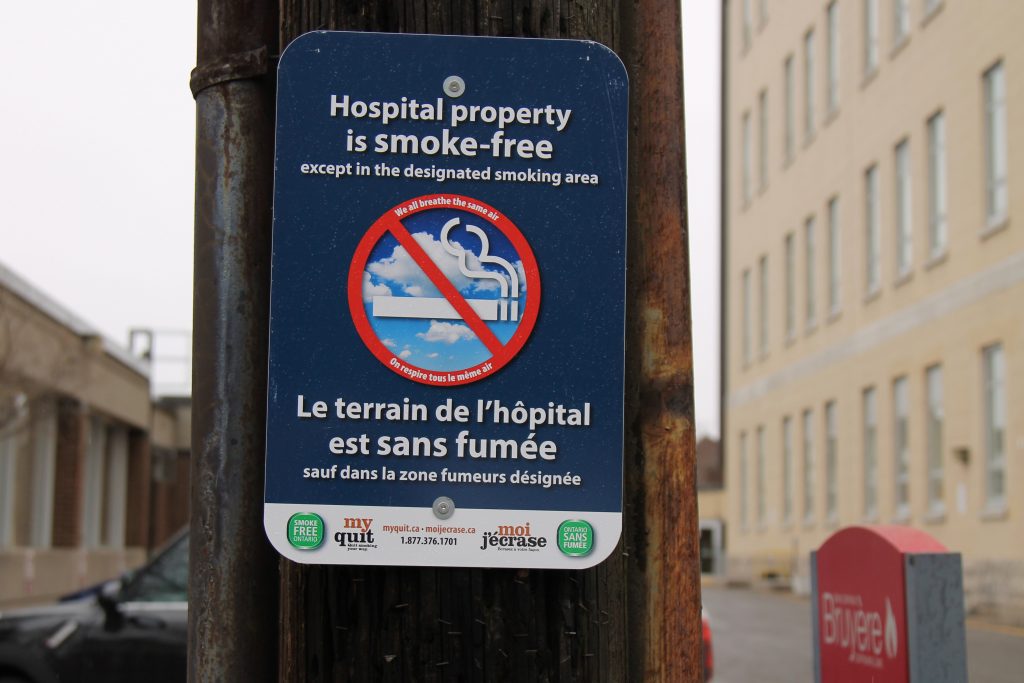Saint-Vincent Hospital has removed its designated smoking area from property
By Lauren McIvor
Every day since Jan. 1, Barbra McRae has sat outside Saint-Vincent Hospital in harsh winter temperatures to have a cigarette, just metres away from the “No Smoking” signs that line the property.
She lives in continuing care at the hospital, and uses an electric wheelchair to get around. She has to battle snow and ice to get far enough away from the property to avoid hefty fines when she lights up.
Up until Jan. 1, this wasn’t the case.
Changes to the Smoke-Free Ontario Act came into effect at the beginning of the month, with patients, visitors and staff now having to leave hospital grounds for their cigarette breaks.
Previously, hospitals had designated smoking areas.
“That was bad enough,” said McRae. “But now we’re on the street.”
For patients like McRae, new laws and regulations won’t stop them from heading outside to smoke. And getting rid of designated smoking areas, she said, has gone too far.
“We are sick people,” McRae said, “It doesn’t matter what hospital you’re in, we’re sick. It’s like you’re down and you’re getting kicked down farther. I don’t like it.”
McRae said that some staff members have started helping patients that need assistance, but getting rid of designated areas has taken away some of the little freedom that patients have. She also said she doesn’t believe that the new law will encourage smokers to quit anytime soon.
“I just want to enjoy the rest of my life that I have and I enjoy smoking,” she said. “That’s where my friends are. If you go to any hospital, where you’re going to get the talkers is the smoking area.”
Gaetan Belanger, whose father lives at the hospital, said that having to leave the property to smoke during his visits is an inconvenience, but that it doesn’t affect him nearly as much as the patients.
“For these people, this is their home and they don’t have the space to smoke anymore,” he said. “They’re not allowed to smoke on their own property.”
Krista Oswald, a project officer with Ottawa Public Health’s tobacco prevention program, said that she highly recommends that smokers use nicotine replacement therapy when they’re in hospital in order to abstain from smoking.
“This is really put in place,” she said, “to protect those people that are going to the hospital for various reasons — protecting them from the second hand smoke.”
For patients, staff, and visitors who want to quit, hospitals are providing additional resources and information about support services.
Saint-Vincent is directing people to programs such as MyQuit, which provides centralized access to local quit-smoking services in Eastern Ontario communities.
Laurie Dojeiji, Program Manager at the Champlain Cardiovascular Disease Prevention Network, refers to MyQuit as a comprehensive approach to kicking the habit.
She said that because MyQuit brings together Ottawa Public Health with other partners in the region, it simplifies access to the services that are offered by MyQuit partners.
Dojeiji supports the new legislation, even though it is still too early to gauge the effects of the law. “I think that we have to be able to appreciate that tobacco use is very much an addiction,” she said, “and so we need to provide a variety of different resources that can respond to the needs of smokers to help them quit and provide all access for them to be able to do that.”

